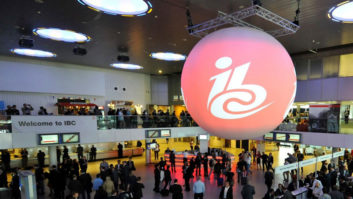With a portentous ceremony involving Also sprach Zarathustra and an obelisk, Omneon launched its MediaGrid active storage system in Vegas, billing it as the first content storage system of its kind designed specifically for the demands of working with large digital media files within broadcast and video production facilities.
Combining grid storage and grid computing through the use of multiple intelligent, interconnected-yet-independent storage servers, the company says that the new system dramatically enhances the efficiency of digital media access for users and applications across the entire broadcast workflow.
MediaGrid provides centralised shared storage that is scalable in capacity, bandwidth, and media processing power, while its modular design utilises industry-standard components and connectivity to create a highly configurable, reliable, and what Omneon claims is a cost-effective system. Components of the system communicate over standard Ethernet and generate massive aggregate bandwidth that is available to external clients of the system, eliminating bottlenecks associated with traditional shared-storage environments. Each storage component is also a media processing engine, making computational resources available to applications for media processing functions while content resides within the storage system.
“MediaGrid is an incredibly elegant solution that takes many individual off-the-shelf industry standard components and makes them work together in a more intelligent manner, ultimately creating a system that is more affordable, more powerful, and easier to use than other storage systems,” said Geoff Stedman, vice president of marketing for Omneon. “No longer is storage just a passive repository of data – we’ve made MediaGrid an active part of the workflow by utilising the integrated processing power of each component to perform media processing functions on stored content.”
The main components of a MediaGrid system are ContentDirectors and ContentServers. ContentDirectors act as the overall file system controllers, managing the distribution of data throughout the system and providing data maps to clients for retrieval of media from the system. ContentServers are the engines that actually store and provide access to media. ContentServers, available in 2TB “high-bandwidth” and 12TB “high-capacity” configurations, are individual storage servers that provide a combination of storage capacity, high-bandwidth network access, and processing power. ContentServers act as smart nodes on an interconnected grid that require no assistance from the ContentDirectors to communicate with clients or one another.
The MediaGrid architecture is based on a distributed file system designed to address the particular needs of managing large media files. MediaGrid uses a file segmentation scheme that employs file slices as the unit of storage, instead of the traditional blocks used by conventional data storage systems. Every file is divided into slices, which are then stored in multiple locations across the pool of ContentServers. Redundant ContentDirectors manage the distribution of slices and maintain the database of slice locations. A slice on the MediaGrid – which has a nominal size of 8MB – is stored and retrieved from the storage pool in an intelligent fashion, which ensures both integrity and performance of the system. Multiple replicas of each slice are created in the process and redistributed to other drives on other ContentServers based on an adjustable replication factor. This allows MediaGrid to provide greater resiliency and bandwidth for critical or high-demand content than for less-used, aged content.
Application developers have not been slow in coming onboard. Those who have committed to supporting the Omneon MediaGrid to date include Anystream, Ardendo, Blue Order, Crispin Corporation, Florical Systems, Front Porch Digital, Ibis, Konan Digital, MassTech Group, OmniBus Systems, Pebble Beach Systems, Pharos Communication, Pictron, Probel, Rhozet, S4M, Snell & Wilcox, Sundance Digital, Starfish, TMD, Tektronix, Telestream, and Venaca.







